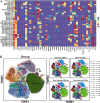Characteristics of circulating immune cells in HBV-related acute-on-chronic liver failure following artificial liver treatment
- PMID: 38007423
- PMCID: PMC10676598
- DOI: 10.1186/s12865-023-00579-8
Characteristics of circulating immune cells in HBV-related acute-on-chronic liver failure following artificial liver treatment
Abstract
Background and aim: Liver failure, which is predominantly caused by hepatitis B (HBV) can be improved by an artificial liver support system (ALSS). This study investigated the phenotypic heterogeneity of immunocytes in patients with HBV-related acute-on-chronic liver failure (HBV-ACLF) before and after ALSS therapy.
Methods: A total of 22 patients with HBV-ACLF who received ALSS therapy were included in the study. Patients with Grade I according to the ACLF Research Consortium score were considered to have improved. Demographic and laboratory data were collected and analyzed during hospitalization. Immunological features of peripheral blood in the patients before and after ALSS were detected by mass cytometry analyses.
Results: In total, 12 patients improved and 10 patients did not. According to the immunological features data after ALSS, the proportion of circulating monocytes was significantly higher in non-improved patients, but there were fewer γδT cells compared with those in improved patients. Characterization of 37 cell clusters revealed that the frequency of effector CD8+ T (P = 0.003), CD4+ TCM (P = 0.033), CD4+ TEM (P = 0.039), and inhibitory natural killer (NK) cells (P = 0.029) decreased in HBV-ACLF patients after ALSS therapy. Sub group analyses after treatment showed that the improved patients had higher proportions of CD4+ TCM (P = 0.010), CD4+ TEM (P = 0.021), and γδT cells (P = 0.003) and a lower proportion of monocytes (P = 0.012) compared with the non-improved patients.
Conclusions: Changes in effector CD8+ T cells, effector and memory CD4+ T cells, and inhibitory NK cells are associated with ALSS treatment of HBV-ACLF. Moreover, monocytes and γδT cells exhibited the main differences when patients obtained different prognoses. The phenotypic heterogeneity of lymphocytes and monocytes may contribute to the prognosis of ALSS and future immunotherapy strategies.
Keywords: Acute-on-chronic liver failure; Artificial liver support system; Hepatitis B; Immunophenotype; Mass cytometry.
© 2023. The Author(s).
Conflict of interest statement
The authors declare no competing interests.
Figures




Similar articles
-
Effect of artificial liver support system on short-term prognosis of patients with hepatitis B virus-related acute-on-chronic liver failure.Artif Organs. 2020 Oct;44(10):E434-E447. doi: 10.1111/aor.13710. Epub 2020 May 12. Artif Organs. 2020. PMID: 32320491 Clinical Trial.
-
Artificial Liver Support System Improves Short-Term Outcomes of Patients with HBV-Associated Acute-on-Chronic Liver Failure: A Propensity Score Analysis.Biomed Res Int. 2019 Nov 29;2019:3757149. doi: 10.1155/2019/3757149. eCollection 2019. Biomed Res Int. 2019. PMID: 31871940 Free PMC article.
-
Artificial Liver Support System Improves One-Year Prognosis of Patients With Hepatitis B Virus-Associated Acute-on-Chronic Liver Failure.J Gastroenterol Hepatol. 2025 Apr;40(4):940-948. doi: 10.1111/jgh.16883. Epub 2025 Jan 27. J Gastroenterol Hepatol. 2025. PMID: 39871448
-
Artificial liver support systems for hepatitis B virus-associated acute-on-chronic liver failure: A meta-analysis of the clinical literature.J Viral Hepat. 2023 Feb;30(2):90-100. doi: 10.1111/jvh.13767. Epub 2022 Nov 18. J Viral Hepat. 2023. PMID: 36327289
-
Advanced therapeutic strategies for HBV-related acute-on-chronic liver failure.Hepatobiliary Pancreat Dis Int. 2015 Aug;14(4):354-60. doi: 10.1016/s1499-3872(15)60338-1. Hepatobiliary Pancreat Dis Int. 2015. PMID: 26256078 Review.
Cited by
-
Metabolic Dysregulation and Metabolite Imbalances in Acute-on-chronic Liver Failure: Impact on Immune Status.J Clin Transl Hepatol. 2024 Oct 28;12(10):865-877. doi: 10.14218/JCTH.2024.00203. Epub 2024 Sep 19. J Clin Transl Hepatol. 2024. PMID: 39440217 Free PMC article. Review.
References
Publication types
MeSH terms
Grants and funding
- 2018ZX10101-001/National Science and Technology Major Project
- 2018ZX10101-001/National Science and Technology Major Project
- 2018ZX10101-001/National Science and Technology Major Project
- 2018ZX10101-001/National Science and Technology Major Project
- 2018ZX10101-001/National Science and Technology Major Project
- 2018ZX10101-001/National Science and Technology Major Project
- 2018ZX10101-001/National Science and Technology Major Project
- 2018ZX10101-001/National Science and Technology Major Project
- LQ17H030002/Youth Fund Project of Zhejiang Provincial Natural Science Foundation
- LQ17H030002/Youth Fund Project of Zhejiang Provincial Natural Science Foundation
- LQ17H030002/Youth Fund Project of Zhejiang Provincial Natural Science Foundation
- LQ17H030002/Youth Fund Project of Zhejiang Provincial Natural Science Foundation
- LQ17H030002/Youth Fund Project of Zhejiang Provincial Natural Science Foundation
- LQ17H030002/Youth Fund Project of Zhejiang Provincial Natural Science Foundation
- LQ17H030002/Youth Fund Project of Zhejiang Provincial Natural Science Foundation
- LQ17H030002/Youth Fund Project of Zhejiang Provincial Natural Science Foundation
LinkOut - more resources
Full Text Sources
Medical
Research Materials

